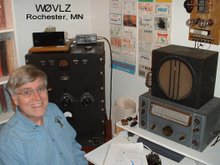

I wondered if my 80 mtr top loaded vertical is a good antenna for the Bruce Kelley Memorial 1929 CW QSO Party. Part of the loading is the top 6' of two of the guys. Any sway at all causes a guy to sag a little shifting the load my Hartley sees. This causes my signal to FM/wobble...distracting to say to least and aggravating if the band is crowded. I needed to know if the gain offered by the vertical over my endfed wire was enough to outweigh the the wobble it introduced.

The reverse beacon network at http://www.reversebeacon.net/ allowed me to get a good idea of real antenna performance. All I had to do is call
 CQ and any reverse beacon stations hearing me automatically posts my call, frequency and signal strength to the web. By switching between my low endfed wire and my vertical I could get a good A vs B comparison. By doing this over a period of time I could see how changing nighttime propagation impacts this comparison. Monday night I did exactly this and then sorted though the data to see how the two antennas compare from about 8PM (2:00 UTC) through the next morning.
CQ and any reverse beacon stations hearing me automatically posts my call, frequency and signal strength to the web. By switching between my low endfed wire and my vertical I could get a good A vs B comparison. By doing this over a period of time I could see how changing nighttime propagation impacts this comparison. Monday night I did exactly this and then sorted though the data to see how the two antennas compare from about 8PM (2:00 UTC) through the next morning.What I found was that for the east coast (PA) the vertical offered 8-10 dB gain throughout the night. While not always a spectacular performer it is almost always better than my endfed wire...but signal reports all mention the wobble/FMing introduced by antenna sway. Based on this I'll stick with my endfed wire for the early evening hours and then switch after about 10PM when the band activity dies down a little.
For next year's Bruce Kelley QSO Party it would be nice to have this problem solved by building a '29 style amplifier to use with my Hartley. Fortunately my 1934 transmitter already has an amplifier stage in between the oscillator and the antenna. My vertical will work fine with this transmitter during the AWA Linc Cundall Memorial CW Contest in January.

3 comments:
Wobble/swaying of a vertical? What do you expect the frequency of the wobble to be? Maybe 1 cycle/sec or 1/2 cycle per sec? How could that freq cause noticeable FMing? Is this what you were thinking? Thanks, Guy/N7UN
I too have used the RBN for antenna A/B measurements but made comparisons over a very short time period...like 1 hr or less in order to get a lot of data points from both antennas during the test period.
Guy, all measurements were made with my 100 watt ICOM so that I could compare antenna performances. I wanted to know how changing propagation changed the comparison so I took measurements every hour overnight. I then sorted through the data to compare only reports from the same stations over the test period.
My station during the AWA (Antique Wireless Association) contest included a 1929 style transmitter. This transmitter is a one tube non-crystal controlled oscillator coupled straight to the antenna with no buffer stage. Properly set up it sounds OK on the air but any change in antenna loading (such as caused by swaying in the wind) can cause noticeable FMing on the CW signal (but typically less than 100Hz) This was OK in the 30s. It is more of an issue now. This is why I needed to know the gain added by the vertical vs the wobble it will cause to my signal. Listen to http://www.prismnet.com/%7Enielw/1928Hartley/W0VLZ5Nov09ByVE7SL.mp3 to hear how my 2 watt Minn signal sounded in Brit Col.
Hi Niel...yes, listening to the .mp3 you can hear the freq tone shift. At the base of your cap-hat loaded vertical, are you using any kind of balun to isolate the coax shield from the antenna itself? I'm just surprised that a 1 foot or so antenna sway can impact the xmitter loading that much. Clearly the antenna system (including the coax) is part of the tube output circuit. Interesting.
Post a Comment